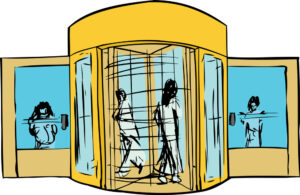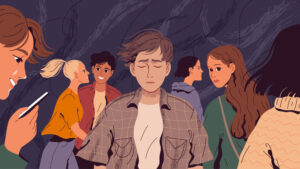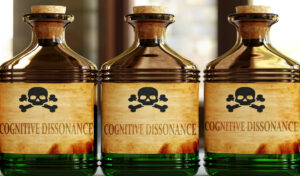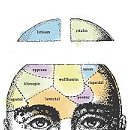During 2024, we published 155 blogs, 244 reviews of scientific findings, 43 personal stories and 41 MIA reports, of which 22 were podcast interviews. This year’s webinars have included discussions on neuroplasticity and protracted withdrawal, supporting extreme states and private film screenings with Q&A including Saving Minds directed by Catherine Mullins.
Please donate to help us continue our work in 2025 and beyond. You can become a MIA Supporter for $5 per month or $20 annually. Subscribers get free access to all Mad in America content and webinar events.
Here we highlight the top ten of Mad in America’s most-read blogs and personal stories of 2024.
Searching for the “Psychiatric Yeti”: Schizophrenia Is Not Genetic
 In January, Peter Simons wrote that the decades-long attempt to locate the gene or genes for schizophrenia has failed, according to a new article in Psychiatric Research by prominent schizophrenia researcher E. Fuller Torrey.
In January, Peter Simons wrote that the decades-long attempt to locate the gene or genes for schizophrenia has failed, according to a new article in Psychiatric Research by prominent schizophrenia researcher E. Fuller Torrey.
Torrey writes, “Over twenty years later not a single gene has been identified to cause schizophrenia, despite the expenditure of almost $8 billion in genetic research by NIMH. Nor have any new treatments become available from this research.
NIMH invested extensive resources in this research with little to show for it and at the expense of alternative research projects. Since schizophrenia does not appear to be a genetic disorder, NIMH’s research portfolio should be reviewed.”
Torrey suggests that the NIMH should focus on basic research into the biological causes of schizophrenia, including his pet theory, that schizophrenia is caused by immunological problems (lead candidate: toxoplasma gondii). He also suggests that the NIMH should fund more clinical trials in an effort to develop new drugs to treat the disorder.
However, the NIMH’s tight focus on funding genetic research has also prevented the exploration of the known psychological causes of schizophrenia, such as the impact of trauma, isolation, and poverty. It has also prevented the proliferation of non-biological understandings of psychosis, such as the Hearing Voices movement, and non-medical treatments, like Open Dialogue and Soteria.
The Revolving Door of Mental Illness: Unveiling the Limitations of Current Psychiatric Approaches
 Also in January, Kelli Grant covered a study which suggested that mental health treatments fall short and fail to prevent a ‘revolving door’ effect.
Also in January, Kelli Grant covered a study which suggested that mental health treatments fall short and fail to prevent a ‘revolving door’ effect.
A groundbreaking study led by Rachel E. Menzies from The University of Sydney, published in the British Journal of Clinical Psychology, delves into the recurring cycle of mental health issues, known as the ‘revolving door’ phenomenon in mental health services. This study, titled “The ‘revolving door’ of mental illness: A meta-analysis and systematic review of current versus lifetime rates of psychological disorders,” not only sheds light on this pattern but also raises critical questions about the limitations of current diagnostic systems and the effectiveness of psychiatric treatments.
The study’s findings, which show that the average number of lifetime disorders is nearly twice that of current disorders, highlight a disconnect between the current psychiatric approach and the complex, evolving nature of mental health. This insight underscores the pressing need for more adaptive, transdiagnostic treatment methods and a broader understanding of relapse prevention, moving beyond the constraints of traditional psychiatric practices.
Accounting for Mental Disorder: Time for a Paradigm Shift
 Allan Leventhal, author of Grifting Depression: Psychiatry’s Failure as a Medical Science, writes that “Ten years ago the WHO called for a paradigm shift in mental health care. That has not happened. Mental health care is under the control of powerful entities: the profession of psychiatry, drug companies, NIMH, primary care doctors, and insurance companies. They are all committed to a biological/medical model, and they all have turned a deaf ear to the idea of this paradigm shift. Ideology and economic interests furnish the explanation for this resistance.
Allan Leventhal, author of Grifting Depression: Psychiatry’s Failure as a Medical Science, writes that “Ten years ago the WHO called for a paradigm shift in mental health care. That has not happened. Mental health care is under the control of powerful entities: the profession of psychiatry, drug companies, NIMH, primary care doctors, and insurance companies. They are all committed to a biological/medical model, and they all have turned a deaf ear to the idea of this paradigm shift. Ideology and economic interests furnish the explanation for this resistance.
If the paradigm is to shift the most crucial members on this list are primary care doctors. Primary care doctors are the rank and file of health care. Right now, they believe they have reason to be committed to a biological/medical orientation for their patients’ mental health care as well as for their treatment of physical illness.”
The Death of Joey Marino
 In April 2024, Carly McCarter told the tragic story of the death of her friend, actor Joey Marino. Joey experienced akathisia from drugs prescribed for anxiety and he sadly died on January 14th 2024. Carly tells that Joey was on almost thirty different medications between 2015 and 2024.
In April 2024, Carly McCarter told the tragic story of the death of her friend, actor Joey Marino. Joey experienced akathisia from drugs prescribed for anxiety and he sadly died on January 14th 2024. Carly tells that Joey was on almost thirty different medications between 2015 and 2024.
“Joey developed akathisia, tardive dyskinesia and dystonia around 2021. No one could tell him what it was. Not until he was in the emergency room in Los Angeles where a doctor acknowledged that this was medication harm and what he was experiencing were side effects.
Joey’s life was disabled by these medications. He had developed a severe movement disorder and dealt with constant twisting in his hands, fingers, arms and all over his body. He wanted to be able to work out and not have to pay for it with the severe movements and twisting. Even when it came to eating it would go against him as his dopamine was stripped from him. Whenever he ate something red like pizza, it would cause his akathisia to flare up.
Joey passed away in the early morning hours of January 14th after a difficult ten-year battle. He didn’t want to live the rest of his life bedridden and no longer able to enjoy the life that he once had and loved so much.”
Arrested Development: Britney Spears’ Memoir Is a Survivor’s Tale of Generational Trauma, Psychiatric Abuse, and Resilience
 Miranda Spencer shares her thoughts on Britney’s memoir entitled The Woman in Me.
Miranda Spencer shares her thoughts on Britney’s memoir entitled The Woman in Me.
“The Woman in Me reveals the full extent of Spears’ father’s and co-conservators’ infantilization of her over those 13 years, during which she felt like “a sort of child-robot…stripped of my womanhood.” She writes: “Security guards handed me prepackaged envelopes of meds and watched me take them. They put parental controls on my iPhone. Everything was scrutinized and controlled. Everything.”
Indeed: She could not drive her car. Told she was “fat,” she was placed on a strictly enforced diet; she was forbidden not only alcohol but also coffee. Dates had to undergo background checks and be briefed on Britney’s sexual history. She was forbidden to stop using birth control and to marry. Even her bathroom breaks were monitored (“I’m not kidding!”). And her family and colleagues went along with it. “I started to feel like I was in a cult,” she writes.”
New Study Exposes the Trauma of Involuntary Psychiatric Detention
 In July, Richard Sears, wrote about a recent study highlighting the negative experiences of involuntary psychiatric hospital admissions, revealing deep-seated issues of racism, discrimination, and lack of support within the mental healthcare system.
In July, Richard Sears, wrote about a recent study highlighting the negative experiences of involuntary psychiatric hospital admissions, revealing deep-seated issues of racism, discrimination, and lack of support within the mental healthcare system.
“Our findings suggest that the experience of involuntary treatment and compulsory admissions is an often predominantly negative, at times traumatic experience for service users and carers, not always achieving the expected therapeutic benefit.”
The researchers systematically reviewed research on service user and carer experiences of involuntary psychiatric admissions. The findings are stark: many service users report negative and often traumatic experiences compounded by systemic racism and discrimination. Carers, too, face emotional distress and frustration with a system that frequently dismisses their insights and needs. This comprehensive analysis highlights the urgent need for reform in mental healthcare, advocating for a more humane and context-sensitive approach to treatment and support.”
It’s You, It’s Not Me: Treatment Resistant Depression and the Psychiatric Breakup
 Josh Hines wrote It’s You, It’s Not Me: Treatment Resistant Depression and the Psychiatric Breakup in June 2024. In it, he examines the concept of ‘treatment-resistant depression’.
Josh Hines wrote It’s You, It’s Not Me: Treatment Resistant Depression and the Psychiatric Breakup in June 2024. In it, he examines the concept of ‘treatment-resistant depression’.
“An article about “Treatment-resistant depression,” ought to define treatment-resistant depression. This is hard to do; there is no universal understanding of the term. Hundreds of articles are devoted to defining it, observing that it is yet to be defined or saying we should really get on top of defining it. A condition that affects thirty percent of depressed people can’t be pinned down, meaning that it might only affect fifteen percent of depressed people, or fifty, depending on who you ask. When we speak of treatment-resistant depression (TRD), we do so in broad parameters.
TRD is mostly understood as depression that doesn’t improve with medication or other medical procedures. Studies disagree on how many medications need to be tried before depression can be called treatment-resistant, or what is a reasonable amount of time to try each medication or what is an acceptable improvement. Is a patient treatment-resistant after trying one med or eight? For two months or six? Should they be a little better or in remission? And who gets to draw these lines?”
Global Study Questions Antidepressant Use, Points to Social Determinants of Mental Health
 In February, Liam Gehrig Bach wrote about a new cross-national study which questions the effectiveness of antidepressants, highlighting the crucial role of social and economic factors in addressing global mental health challenges.
In February, Liam Gehrig Bach wrote about a new cross-national study which questions the effectiveness of antidepressants, highlighting the crucial role of social and economic factors in addressing global mental health challenges.
“The findings reinforce the view that addressing the high prevalence rates of depression via symptom recognition and treatment with antidepressants is unlikely to be effective. The absolute long-term efficacy of antidepressants in real-world settings is disappointingly modest. This low effectiveness for antidepressants (and depression treatments in general, if we are honest) at the population level suggests that decreasing the treatment gap will have little impact on the community prevalence of depression,” the researchers write.
“However, the fact that income, education, and life expectancy (as measured using the HDI) are significantly associated with the prevalence of sadness, worry, and unhappiness suggests that alternative ways of addressing depression at a community level might be more productive.”
Types of Trauma Exposures Predict Specific Psychosis Symptoms
 Writing in June 2024, Ashley Bobak examined a new study exploring the role that types of cumulative exposures to trauma have on the development of specific psychotic symptoms.
Writing in June 2024, Ashley Bobak examined a new study exploring the role that types of cumulative exposures to trauma have on the development of specific psychotic symptoms.
The study was led by Mohamed A. Zoromba of the College of Nursing at Prince Sattam Bin Abdulaziz University in Saudi Arabia. The research team comprised individuals from psychiatry and nursing departments in universities across Egypt and Saudi Arabia. They found that exposure to total cumulative trauma was a predictor of hallucinations, disorganized speech, abnormal psychomotor behavior, depression, and mania.
The researchers also found that certain types of cumulative traumas are linked to an increased risk for specific psychotic symptoms. For example, “attachment trauma,” related to early childhood experiences like abandonment, was connected to hallucinations, abnormal psychomotor behavior, and mania.
The researchers also offered an interpretation of how exposure to cumulative trauma may predict psychosis:
“Exposure to accumulated trauma experiences accompanied with ineffective coping modalities may affect the interpretations of the human mind to daily life events or stressors, which may enhance the separation of the integrated components of the human mind, namely, intellect, affect, and behavior, leading to the emergence of psychotic symptoms.”
As a result, the researchers emphasize the need for a more holistic, trauma-informed, and person-centered approach to understanding and treating psychotic symptoms.
Psychotherapy Without Antidepressants Shows Best Results for Depression
 In February, Peter Simons covered a new study which found psychotherapy alone to be the best first-line intervention option to mitigate the risk of suicide attempts and other serious psychiatric adverse events.
In February, Peter Simons covered a new study which found psychotherapy alone to be the best first-line intervention option to mitigate the risk of suicide attempts and other serious psychiatric adverse events.
According to the researchers, psychotherapy alone beats antidepressants alone, but it also beats combination therapy (drugs plus therapy) for people with depression. Harvard researcher Nur Hani Zainal published this new analysis in Psychological Medicine.
“The present meta-analysis consistently found that psychotherapy monotherapy had stronger aggregate effects than combined treatment and ADM-only in decreasing the probability of suicide attempt, psychiatric ED visit, psychiatric hospitalization, and/or suicide death for MDD patients,” Zainal writes.
The finding contradicts conventional wisdom, which claims that combining antidepressants (ADMs) with psychotherapy is the most effective treatment for people with depression (MDD).
















You write “Please donate to help us continue our work in 2025 and beyond.”
I ask, Do you have a physical (snail) mail address to donate to? If sending a cheque, who do we title it to?
Report comment
Mad in America Foundation
763 Massachusetts Avenue, Suite #3
Cambridge, MA 02139 617-649-1148
Report comment
Editors:
If you sifted your data for the 10 most popular articles for 2024 to be truthful and aligned better with the practice of science, should you also present the 10 least popular articles for 2024. For the context of our challenge I believe is not a popularity context; rather how to affirm the richer humanity of the stuff that is causal to our Being is within this moment! So, seize the forum and understand the spectrum of LIFE! Better in the New Year!
Report comment